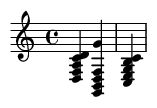Summary:
The bebop major scale is an eight-note scale that adds a chromatic passing tone between the fifth and sixth degrees of the major scale. This sophisticated scale is a cornerstone of the bebop language, designed to create smooth, continuous eighth-note lines where chord tones land on strong beats. Mastering it is essential for developing an authentic jazz vocabulary.
Keywords:
bebop major scale, jazz improvisation, chromatic passing tone, major scale, bebop vocabulary, eighth-note lines, chord-scale theory, melodic development, jazz theory
Introduction: What is the Bebop Major Scale?
In the fast-paced world of bebop, improvisers needed tools to navigate chord changes with fluid, eighth-note-driven melodies. While the major scale has seven notes, this creates a rhythmic problem: if you play a continuous eighth-note line, the chord tones don't consistently align with the strong beats. The bebop major scale solves this by adding a single chromatic passing tone, creating an eight-note scale. This elegant solution, similar in concept to the bebop dominant scale, allows musicians to weave intricate lines over major chords while maintaining rhythmic integrity and melodic grace.
Scale Construction: From Major to Bebop Major
The bebop major scale is built by taking a standard major (Ionian) scale and inserting a chromatic passing tone between the 5th and 6th degrees. This added note is the sharp-five (#5) or flat-six (b6).
The scale formula is: 1 - 2 - 3 - 4 - 5 - #5 - 6 - 7
C Bebop Major Scale Example:
Listen to the characteristic sound of the scale with its added #5 (G#).

The Rhythmic Function: Hitting the Changes
The primary purpose of any bebop scale is rhythmic. The eight-note structure ensures that when you play a continuous eighth-note line starting on a downbeat, the chord tones (1, 3, 5, and 7 of the underlying chord) will naturally land on the strong beats (1, 2, 3, 4), while the other notes (including the chromatic passing tone) fall on the weak upbeats ('and'). This creates the smooth, flowing melodic contour that is a hallmark of the bebop style.
Beat Alignment Illustrated:
Notice how the chord tones (CT) of C Major 7 (C, E, G, B) land on the beats, while passing tones (PT) land on the upbeats.

Harmonic Applications
The bebop major scale is the perfect choice for improvising over any major-quality chord. Its primary application is over tonic major chords in major key centers and ii-V-I progressions. The added #5 resolves smoothly to the 6th (A in the key of C), which is a beautiful color tone over a major chord, often implying a Major 6 or Major 6/9 sound.
Compatible Chords:
- Major 7 (e.g., CMaj7): The most common application.
- Major 6 (e.g., C6): The scale strongly emphasizes the 6th.
- Major 6/9 (e.g., C6/9): Incorporates both the 6th and 9th (D).
- Major Triad (e.g., C): Works perfectly over a simple major chord.
Melodic Patterns & Licks
Musicians don't just play scales up and down; they use them to create melodic ideas. Descending lines are particularly common in the bebop language, as they allow the improviser to resolve down to a chord tone.
Classic Descending Bebop Line:
This is a quintessential bebop phrase. Starting on the root an octave higher, the line descends through the bebop major scale, landing squarely on the 3rd (E) on the downbeat of the next measure.
Practice Techniques for Fluency
To internalize the sound and feel of the bebop major scale, move beyond simply playing it up and down. Practice patterns and sequences that force you to navigate the scale in non-linear ways. This builds technical facility and prepares you to use the scale creatively in an improvisation.
Practice Exercise: Scale in Thirds
Playing the scale in melodic thirds is a classic method for developing finger dexterity and ear training.

Integration with Other Bebop Scales: The ii-V-I
The true power of bebop scales is revealed when you combine them to navigate chord progressions. The most common progression in jazz is the ii-V-I. A player might use a Dorian mode or Dm7 arpeggio over the ii chord, the Bebop Dominant scale over the V7 chord, and finally, the Bebop Major scale over the I chord. This creates a seamless, logical, and stylistically authentic melodic line.
ii-V-I Application in C Major:
This example shows a line moving through Dm7 - G7 - CMaj7. Notice the G Bebop Dominant scale (with its F# passing tone) resolving into the C Bebop Major scale (with its G# passing tone).

Harmonic Analysis: The Function of Each Note
Understanding the role of each scale degree helps in making conscious melodic choices. While the #5 is the defining "bebop" note, every note has a function relative to the tonic chord (e.g., CMaj7) .
Scale Degree Functions in C Bebop Major:
- 1 (C): Root. The strongest point of resolution and stability.
- 2 (D): Major 9th. A colorful extension, often used as a passing tone.
- 3 (E): Major 3rd. Defines the major quality of the chord. A primary target note.
- 4 (F): Perfect 4th. An "avoid note" on a Maj7 chord, used best as a quick passing tone.
- 5 (G): Perfect 5th. A stable chord tone and strong melodic anchor.
- #5 (G#): Chromatic Passing Tone. The "bebop note." Creates tension that resolves beautifully up to the 6th.
- 6 (A): Major 6th. A consonant, colorful extension. Sounds great over major chords.
- 7 (B): Major 7th. A key color tone for a Maj7 chord; provides tension resolving to the root.
Historical Context and Key Players
The bebop major scale wasn't invented in a vacuum or written in a textbook; it emerged organically from the playing of 1940s jazz pioneers. Musicians like pianist Bud Powell and trumpeter Clifford Brown are exemplary models of its use. Their solos are filled with fluid lines that expertly weave this chromaticism into major key harmony. These concepts were later analyzed and codified by jazz educators like David Baker and Jerry Coker, making them accessible to future generations.
Technical Considerations for Musicians
Achieving a smooth, effortless sound with this scale requires attention to the mechanics of your instrument.
- Pianists: Work out comfortable fingerings for the chromatic G-G#-A movement in all keys. Practice descending and ascending patterns to avoid hesitation.
- Guitarists: Map out efficient fingerings across different positions on the fretboard. The chromatic passing tone may require a quick position shift or a stretch.
- Wind/Brass Players: Focus on consistent articulation. Practice slurring over the chromatic passing tone to create a fluid sound, contrasting with tongued notes on the beat.
Conclusion: Your Next Step in Jazz Improvisation
The bebop major scale is more than just a collection of notes; it's a rhythmic and melodic concept. By adding a single chromatic passing tone, it transforms the standard major scale into a powerful tool for creating authentic bebop lines. Internalizing its sound, practicing its application over progressions, and listening to the masters who defined its use are essential steps for any musician looking to deepen their understanding of the jazz language. Start by practicing it in all 12 keys, then apply it to the major chords in your favorite jazz standards.
References:
- Baker, David. (1986). How to Play Bebop, Vol. 1. Alfred Music.
- Coker, Jerry. (1997). Elements of the Jazz Language for the Developing Improvisor. CPP/Belwin.
- Levine, Mark. (1995). The Jazz Theory Book. Sher Music Co.
- Powell, Bud. (1951). The Amazing Bud Powell, Vol. 1. Blue Note Records. [Recording]
- Brown, Clifford & Roach, Max. (1954). Clifford Brown and Max Roach. EmArcy Records. [Recording]
